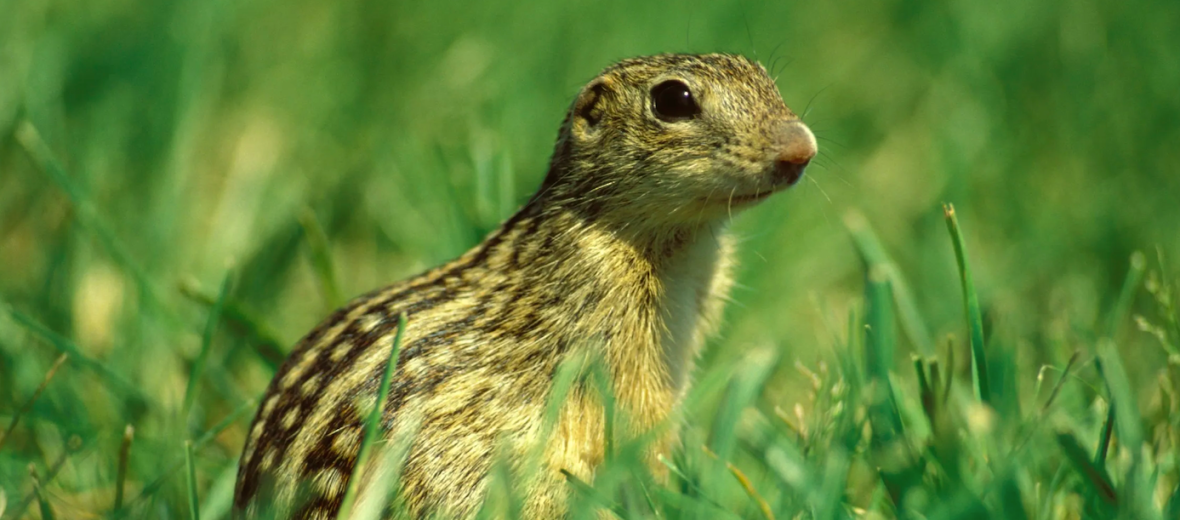
The 13-lined ground squirrel, aka 13 liner, striped ground squirrel, striped gopher, gopher, striper, leopard ground squirrel, leopard-spermophile, or squinney, hails from central Canada down to central United States. 13-liners prefer open habitats with short grass and well-drained sandy or loamy soils. Some are also spotted on golf courses, lawns, parks, and cemeteries. These squirrels are abundant and have a stable population. They are listed as Least Concern by the IUCN.
First the Stats…
Scientific name: Ictidomys tridecemlineatus
Weight: Up to 6.2 ounces
Length: Up to 11 inches, plus up to a 5 inch tail
Lifespan: Up to 7.9 years
Now on to the Facts!
1.) These critters are diurnal (active during the day).
2.) Burrows are constructed that can be both shallow and used for emergency retreats as well as complex, with many chambers for hibernation and birthing their young.
3.) A group of squirrels is called a colony, dray, or scurry.
4.) While not being colonial (gather socially into large groups), their burrows can be found relatively close together, if the soil conditions permit.
5.) They tend to be territorial and will aggressively defend their burrows from other squirrels.
But wait, there’s more on the 13-lined ground squirrel!
6.) Hawks, owls, coyotes, foxes, weasels, and snakes all prey on these little critters.
7.) Communication is conducted via sound and scent.
Did you know…?
Up to 75% of the young are fathered by the 1st male to mate with the females.
8.) 13-lined ground squirrels have excellent senses of touch, sight, and smell.
9.) Being omnivores (eat plant and animal matter), these squirrels feast on grasses, leaves, seeds, insects, small birds, lizards, and even carrion (dead animals).
10.) These squirrels are polygynous (1 male mates with multiple females).
But wait, there’s still more on the 13-lined ground squirrel!
11.) After hibernation, males awaken 1st in order to find suitable partners.
12.) Mating takes place approximately 2 weeks after they awaken from hibernation.
Did you know…?
Up to 90% of the pups are taken by predators before their 1st hibernation.
13.) Females undergo up to a 28 day gestation (pregnancy) that yields up to 14 pups.
14.) These critters are considered true hibernators. This is due to the fact that their body temperature drops to just above freezing and their heart rates slow from 200 beats per minute to just 20!
15.) When they meet with other members of their colony, they will touch noses or lips. This makes it look as though they’re kissing.
But wait, there’s still a little more on the 13-lined ground squirrel!
16.) The 13-lined ground squirrel will rub their scent onto objects, from glands located near their mouth. This scent is used to mark their territory.
17.) The University of Minnesota’s mascot for the Golden Gophers is a 13-lined ground squirrel.
18.) These squirrels can fall up to 98.4 feet without getting hurt!
19.) The children’s book, “Earnest, the Moose Who Doesn’t Fit,” by Catherine Rayner features a 13-lined ground squirrel. The moose and the squirrel work together to accomplish their goals.
20.) In Greek, “squirrel” means shadow tail.
Now a Short 13-Lined Ground Squirrel Video!
Be sure to share & comment below! Also, check out the Critter Science YouTube channel. Videos added regularly!
Want to suggest a critter for me to write about? Let me know here.
Think you know a lot about critters? Try your hand at these fun, free quizzes:



